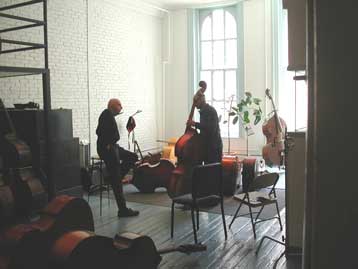
Below are excerpts from an interview with David by Joshua Rosenbaum, published in Bass Player Magazine. The interview deals with many questions of importance to those on the lookout for a new bass.
"When many of New York's top acousitic bass players need to have work done on their instruments or are in the market for another bass, their first stop is invariably David Gage String Instrument Repair in Manhattan's Tribeca district. Gage's clients include such world-class jazz bassists as Dave Holland and Ray Brown as well as first-chair players for the New York Philharmonic and Metropolitan Opera Orchestra. But David doesn't just sell and repair instruments; he also takes the time to listen to his customers, advise them, and educate them. And you don't have to be a pro to patronize his shop - students and amateurs get the same kind of informed and courteous attention as the big names..."
General Questions
Italian basses tend to cost more; the English, French, and German instruments usually have lower prices. Old Italian basses like Guarneris, made in the 18th century, are considered to be better because their sound has huge, wonderful spread. When classical musicians audition for orchestral jobs, the orchestra is looking for that sound. Bu you should be careful, because more money doesn't guarantee you a better bass.
Traditionally, old ones are more in demand; basses and other instruments in the violin family mellow and become better over time, although there are excellent makers of new instruments. Some people say new basses are risky because the wood is green and therefor more likely to crack. That may be true for companies that mass-produce basses, but if you're buying a bass from a good maker, he will have used wood that was air-dried over a considerable period of time, so it shouldn't be a problem. Top-quality new carved-top basses cost $12,000 and up.
It's very important. Plywood basses are often thought of as the kind of instruments you see in high schools - difficult-to-play basses that are poorly set up, with high action. If you start on one of those, it's easy to give up. It's important for a plywood bass to be properly set up and to have a good ebony fingerboard. Many plywood basses coming out now have white wood fingerboards; the necks often warp, which increases the string height and the difficulty of playing.

